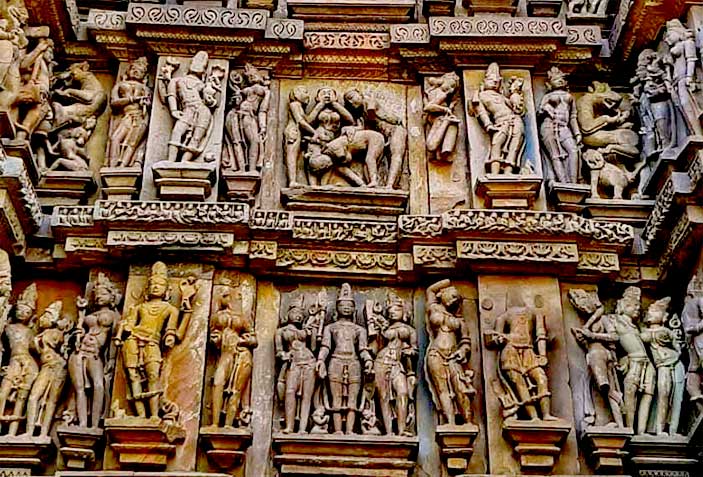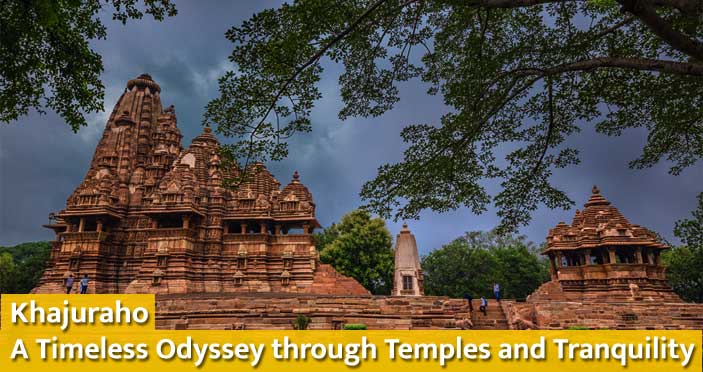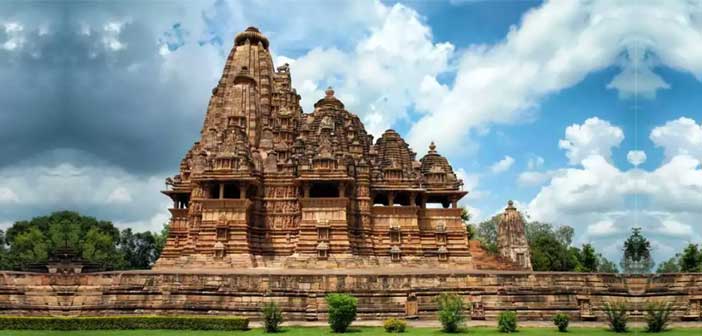Khajuraho, a small town nestled in the heart of India, is a living testament to the architectural prowess and cultural richness of ancient India.
Famed for its group of stunning temples, Khajuraho draws travelers seeking a glimpse into the country’s glorious past.
As I embarked on this journey, I found myself captivated by the enigmatic aura and intricate craftsmanship that permeates every corner of this UNESCO World Heritage Site.
The first rays of the sun bathed the Western Group of Temples, the most renowned cluster in Khajuraho, in a golden glow as I began my exploration.
These temples, built between the 9th and 11th centuries by the Chandela dynasty, showcase a remarkable fusion of religion, art, and erotica.
The exquisite carvings, depicting gods, goddesses, and sensuous figures in various amorous poses, left me in awe of the artistic skills of the ancient craftsmen.

The KandariyaMahadeva Temple, the largest and most ornate of the Western Group, stands as the pinnacle of Khajuraho’s architectural brilliance.
Its spire, adorned with intricate carvings of celestial beings, soars into the sky, making it a visual spectacle.
The Duladeo Temple, dedicated to Lord Shiva, and the Chitragupta Temple, devoted to Surya (the Sun God), are equally enthralling with their detailed sculptures and spiritual ambience.
After a morning immersed in the architectural wonders, I ventured into the Eastern Group of Temples, where the Jain temples awaited.
The Parsvanath Temple, with its serene atmosphere and delicate sculptures, stands as a testament to Jain principles.

The Ghantai Temple, known for its intricate friezes depicting the 16 dreams of Lord Mahavira’s mother, showcased a different facet of Khajuraho’s artistic repertoire.
As the day unfolded, I explored the Southern Group of Temples, including the Duladeo Temple and the Chaturbhuj Temple.
The latter, an incomplete structure with a massive intricately carved monolithic stone idol of Lord Vishnu, added a mystical charm to my journey.
Also read : Are Indian Startups Wired to Fail?
Khajuraho‘s cultural tapestry extends beyond its temples. The Archaeological Museum, located near the Western Group, provides an insightful journey into the history and evolution of Khajuraho’s artistic legacy.
The museum houses a collection of sculptures, artifacts, and photographs, offering a glimpse into the region’s past.
After a day immersed in history and art, I turned my attention to Khajuraho’s culinary delights. The local cuisine, rich in flavors and spices, reflects the diversity of Indian gastronomy.
I indulged in traditional dishes like Poha, a flattened rice preparation, and Dal Bafla, a local specialty akin to the more well-known Dal Baati of Rajasthan.
The street food scene in Khajuraho, though modest, offered delicious treats like Kachori and Samosas, providing a perfect blend of spice and crunch.
As the sun dipped below the horizon, I found myself wandering through the vibrant markets of Khajuraho.
The bustling bazaars are a treasure trove of handicrafts, sculptures, and traditional textiles. Intricately carved stone figurines and replicas of Khajuraho’s famous sculptures are popular souvenirs.
The vibrant colors of local textiles, including sarees and scarves, added a touch of allure to the market experience.
In the evening, I attended the Light and Sound Show at the Western Group of Temples. The illuminated structures, accompanied by a narrative that recounted the history and legends of Khajuraho, created a magical ambiance.
As the sound echoed through the temples, I felt a connection to the rich heritage that defines this ancient town.
Subscribe our Youtube Channel : https://www.youtube.com/@forevernews6213
Khajuraho, with its blend of spirituality, artistry, and culinary delights, offers a multifaceted experience to travelers.
The temples, each a masterpiece in its own right, stand as a testament to India’s glorious past. As I bid farewell to Khajuraho, I carried with me not just memories of the architectural marvels but a profound appreciation for the cultural mosaic that makes India truly incredible.
By Suchithra Iyer





